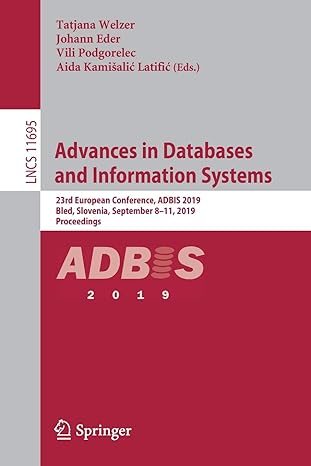Question
c++ please: Program Details and Requirements: 1) An object of type Date should represent a calendar date in terms of month, day, and year, as
c++ please:
Program Details and Requirements:
1) An object of type Date should represent a calendar date in terms of month, day, and year, as on a 12-month A.D. (anno Domini ) Gregorian calendar. The valid months are January through December, a valid day must correspond to a valid day for the given month, and the year must be a positive number above 1582. Your object should also store a format setting, to be used for display of dates to the screen. There will be more than one possible format. The class features (public interface) should work exactly as specified, regardless of what program might be using Date objects.
Note: For purposes of easy input (from keyboard or into functions), date values will be specified with integers. Month values will be 1 for January, 2 for February, etc... on to 12 for December. A valid day value will be an integer between 1 and the number of days in the month. Valid year values are positive numbers above 1582.
the constructor(s): The Date class should have a constructor that allows the user to specify the values for the month, day, and year, using integer values, when the object is declared. If any of the values would result in an invalid date, the constructor should throw out the erroneous information and initialize the object to represent 1/1/2000 (January 1, 2000) instead.
Example Declarations: These declarations should be legal, and the comment gives the initialized date
Date d1; // initializes to Jan 1, 2000
Date d2(3,4,1992); // initializes to March 4, 1992
Date d3(13,30,1990); // invalid month, initializes to Jan 1, 2000 instead.
void Input() This function should prompt the user to enter a date, and then allow the user to input a date from the keyboard. User input is expected to be in the format month/day/year. Whenever the user attempts to enter an invalid date, the Input function should just use the default date
void Show() This function should simply output the date to the screen. There will be more than one possible format for this output, however, and your class will need to store a format setting. The Show function should use the format setting to determine the output. (There will be a member function that allows the setting to be changed). When a Date object is created, the format setting should start out at the "Default" setting. The possible formats are shown in the following table:
| Name | Format | Example | Explanation |
| Default | M/D/Y | 10/4/1998 | This will look like the input from the Input function. Print the month, day, and year as integer values. |
| Two-Digit | mm/dd/yy | 10/04/98 | Fixed size format, in which the month, day, and year values are always 2 digits Some values may need to be padded with a leading zero, and year values always show the low 2 digits. |
| Long | month D, Y | Oct 4, 1998 | This display format should show the abbreviated month name, then the day, and the full year. Month abbreviations are Jan, Feb, Mar, Apr, May, June, July, Aug, Sept, Oct, Nov, and Dec |
| Julian | DDD, Y | 123, 2001 | This displays the Julian Date format. 123 in the Year 2001 is actually May 3rd, 2001. Leading edge zeros are not required. |
bool Set(int m, int d, int y) This function should set the date to the specified values (the first parameter represents the month, the second represents the day, and the third represents the year). If the resulting date is an invalid date, the operation should abort (i.e. the existing stored date should not be changed). This function should return true for success and false for failure (i.e. invalid date sent in).
int GetMonth() int GetDay() int GetYear() These are "accessor" functions, and they should return the month, day, and year, respectively, to the caller.
bool SetFormat(char f) This function allows the caller to change the format setting. The setting should be adjusted inside the object based on the character code passed in. This means that future uses of the Show function will display in this given format until the format is changed. The valid setting codes that can be passed in are:
'D' = Default format 'T' = Two-Digit format 'L' = Long format 'J = Julian format
If an invalid setting code is passed in, do not alter the current format setting. This function should return true for successful format change, and false for failure (invalid setting given).
void Increment(int numDays = 1) This function should move the date forward by the number of calendar days given in the argument. Default value on the parameter is 1 day. Examples:
Date d1(10, 31, 1998); // Oct 31, 1998 Date d2(6, 29, 1950); // June 29, 1950 d1.Increment(); // d1 is now Nov 1, 1998 d2.Increment(5); // d2 is now July 4, 1950
int Compare(const Date& d) This function should compare two Date objects (the calling object and the parameter), and should return: -1 if the calling object comes first chronologically, 0 if the objects are the same date, and 1 if the parameter object comes first chronologically. The function should not change either object. Example:
Date d1(12,25,2003); // Dec 25, 2003 Date d2(5,18,2002); // May 18, 2002 d1.Compare(d2); // returns 1 (since d2 comes first) d2.Compare(d1); // returns -1 (calling object is d2, comes first)
Step by Step Solution
There are 3 Steps involved in it
Step: 1

Get Instant Access to Expert-Tailored Solutions
See step-by-step solutions with expert insights and AI powered tools for academic success
Step: 2

Step: 3

Ace Your Homework with AI
Get the answers you need in no time with our AI-driven, step-by-step assistance
Get Started


